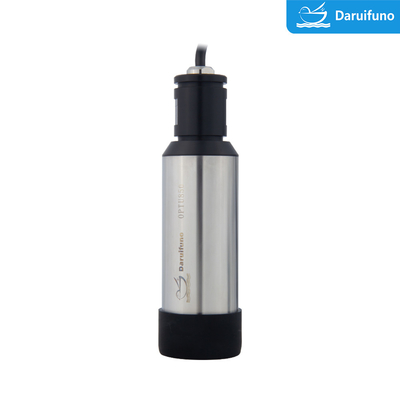RS485 Infrared Turbidity /Suspended Solids Sensor For Sewage Surface Water Plants
Infrared digital turbidity/solid suspended matter sensor OPTU851Z:
Infrared light source: A high-quality infrared light source is usually used inside the sensor to ensure the stability and durability of the light source, thereby ensuring the accuracy of the measurement.
Receiver and detector: The sensor is equipped with a high-sensitivity receiver and detector, which can accurately capture the scattered infrared light, so as to realize the measurement of turbidity or suspended solids.
Digital signal processing: A digital signal processing unit is integrated inside the sensor, which is used to process, calibrate and convert the received signals, and output the measurement results in digital form.
Data output: The sensor outputs the measurement data to the data acquisition system or controller through a digital interface (such as RS-485, MODBUS, etc.) to realize real-time data monitoring and control.
The process advantages and advanced technology of the infrared digital turbidity/suspended solids sensor make it widely used in many application scenarios such as water quality monitoring, sewage treatment, drinking water production, and environmental monitoring. They provide high-precision, high-reliability measurement results that contribute to water safety and environmental protection.
Technical Parameters
| Model |
OPTU850Z |
OPTU851Z |
| Electrical Isolation |
Electrical isolated communication and power interfaces |
| Measuring Technology |
Infrared scattering principle |
| Measuring Range |
Turbidity: 0.01~1000NTU
Suspended solids: 1~3000mg/L
|
Turbidity: 0.01~4000NTU
Suspended solids: 1~3000mg/L
|
| Resolution |
0.01NTU/1mg/L |
0.01NTU/1mg/L |
| Accuracy |
Better than 5% of measured value or 0.3NTU, take the larger one |
Better than 5% of measured value or 1NTU, take the larger one |
| Communication |
RS485 MODBUS-RTU |
| Related Configuration |
Humidity alarm |
| Response Time |
T90<15s |
| Calibration Method |
Multi-point calibration; Contrast Offset; Factor offset |
| Work Pressure |
≤4Bar |
| Sample Flow Rate |
Not dependent |
| Operating Temp |
0~50℃ (does not freeze) |
| Storage Temp |
-10~60℃ (does not freeze) |
| Shell Material |
POM+SS 316L or POM+Titanium alloy |
| Dimension |
Diameter: 52mm length: 260 mm |
| Mounting Thread |
Horizontal installation, dedicated 90° mounting accessories |
| Lead interface |
Split M16 connector |
| Protection Grade |
IP68 |
| Power Supply |
9~24V DC |
| Power Consumption |
0.6W |
| Weight |
700g |
| Cable |
Standard 5 meters (other length can be customized) |
Features
- Based on the infrared absorption and scattering light method
- Use ISO7027 method to continuously and accurately determine turbidity and suspended solids in water
- LED infrared scattering light source (860nm), stable wavelength, stable data
- Reliable performance, simple installation and calibration
- Self-diagnostic function, built-in humidity sensor and a light source detector
- Internal storage of calibration data, support offline calibration, plug and play
- Standard Modbus protocol, support access to standard industrial control system

Infrared digital turbidity sensor / solid suspended matter sensor OPTU851Z application environment:
Water quality monitoring: Infrared digital turbidity sensors can be used to monitor turbidity changes in water bodies such as tap water, surface water, rivers, lakes and reservoirs. In these environments, sensors help assess the cleanliness of water bodies and changes in water quality, as well as detect the presence of suspended particulate matter and pollutants.
Sewage treatment: In sewage treatment plants, infrared digital turbidity sensors can be used to monitor the turbidity of sewage before and after treatment, help evaluate the treatment effect and determine whether further treatment steps are required to ensure that the treated water quality meets the discharge standards.
Aquaculture: In hydroponic and aquaculture farms, infrared digital turbidity sensors can help monitor suspended matter in water to maintain a suitable water quality environment and promote the growth and health of plants and animals.
Industrial process: In some industrial production processes, especially those involving water treatment and suspended particulate matter, infrared digital turbidity sensors can be used to monitor and control the water quality in the production process.
Environmental monitoring: Infrared digital turbidity sensors can also be used in environmental monitoring projects, such as measuring water quality in rivers, lakes and oceans to monitor environmental changes and pollution conditions.
Infrared digital turbidity sensors are widely used in various fields involving water turbidity and suspended solids concentration. They provide a convenient, efficient, and accurate measurement method that contributes to water safety, environmental monitoring, and quality control of industrial production processes.

 Your message must be between 20-3,000 characters!
Your message must be between 20-3,000 characters! Please check your E-mail!
Please check your E-mail!  Your message must be between 20-3,000 characters!
Your message must be between 20-3,000 characters! Please check your E-mail!
Please check your E-mail! 







